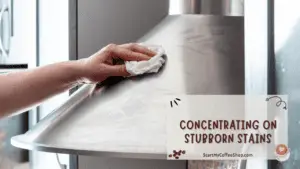Keeping your stainless steel coffee pot clean is critical for retaining the flavor and quality of your favorite drinks. Coffee stains and mineral deposits can form within the pot over time, compromising the flavor and visual appeal of your coffee. Fortunately, you can restore your coffee pot to perfect condition with a simple yet effective cleaning process.
To clean the inside of a stainless steel coffee pot, you should create a solution of equal parts water and white vinegar. Pour it into the pot, allowing it to sit for 30 minutes. Use a brush to scrub, concentrating on stains, and rinse thoroughly with water.
Preparing the Cleaning Solution

Gather the necessary products before beginning the cleaning adventure to restore the sparkling interior of your stainless steel coffee pot. Water and white vinegar are essential materials for this task since they both contribute to the creation of a powerful yet delicate cleaning solution.
Water and white vinegar in equal parts constitute a strong pair that easily removes tough stains and residues. The water acts as a neutral base, reducing the acidity of the vinegar to a safe and effective level for cleaning stainless steel surfaces. This delicate yet effective mixture effectively cleans the interior of your coffee pot while causing no damage to the stainless steel structure.
The active component in this solution is white vinegar, a pantry staple with excellent cleansing capabilities. Its acidic nature aids with the breakdown and dissolution of coffee stains, mineral deposits, and other collected residues in the coffee maker. White vinegar, being a natural disinfectant, also aids in the elimination of bacteria and odors, leaving your coffee pot not only clean but also fresh and ready to prepare your favorite coffee blends.
One of the major advantages of using water and white vinegar is that they are environmentally friendly. Unlike professional cleaning solutions, which frequently contain toxic chemicals, this DIY method is both environmentally responsible and safe for both you and your coffee maker. You can confidently clean your stainless steel coffee pot with this natural cleaning mixture without worrying about harsh residues or detrimental environmental effects.
The simplicity of these substances makes cleaning accessible to everyone. You don’t need to go out and buy pricey equipment or specialized cleansers. Instead, armed with a bottle of white vinegar and some tap water, you can revitalize the interior of your coffee maker.
Read more about: Awakening to Coffee: Exploring Ideal Types for Beginners
Pouring the Solution and Allowing It to Sit
It’s time to start cleaning now that your water and white vinegar mixture is ready. Begin by being cautious when pouring the solution into the coffee maker. Make sure it covers all of the stained areas, allowing the cleaning magic to work its way through any stubborn coffee remnants or mineral deposits that have accumulated over time.
The solution’s potent combination of water and white vinegar begins to take effect as it makes its way into the nooks and crannies of the coffee pot. White vinegar’s acidic characteristics operate as a natural solvent, gradually dissolving the grip of coffee stains and mineral deposits on the stainless steel surface. This progressive dissolving procedure is critical for limiting interior damage while preparing the stains for removal.
Allow the cleaning solution to stay inside the coffee pot for around 30 minutes to allow it to perform its magic. This dwell period is critical because it allows the cleaning chemical to enter the stains and deposits, breaking them down at the molecular level. This transforms the tenacious residues into a more manageable state, making them easier to remove during the cleaning stage.
This waiting period also serves another purpose: it minimizes the amount of effort required during the scrubbing process. The once tenacious and firmly adherent residues become considerably looser and less tightly linked to the stainless steel surface as the solution works to dissolve the stains. As a result, once you start scrubbing, the procedure becomes more efficient, and you may get greater results with less elbow grease.
It’s important to create a balance and avoid allowing the solution to rest for too long, especially if your coffee maker has fragile components or intricate decorations. Certain materials may be harmed by prolonged exposure to vinegar’s acidic characteristics. As a result, sticking to the recommended 30-minute cleaning time achieves the proper balance between effective cleaning and protecting the integrity of your coffee maker.
Scrubbing with a Brush
After the 30-minute waiting period has passed, it’s time to roll up your sleeves and begin cleaning using a soft-bristled brush. The brush used is critical since a harsh or abrasive brush could scratch the delicate surface of the stainless steel coffee pot. Choose a soft-bristled brush made specifically for cleaning to avoid causing any damage to the pot’s interior.
Begin cleaning by concentrating your efforts on places with noticeable coffee stains and mineral deposits. These are the areas that have most likely gathered residue over time and may require additional care. By focusing on these areas first, you will be able to tackle the most resistant places while ensuring an even cleaning result throughout the entire interior.
During the scrubbing procedure, use a delicate but forceful method. While it may be tempting to use too much power to remove stubborn stains, doing so may cause unwanted damage to the stainless steel. Instead, apply gentle pressure and let the cleaning solution release the collected debris. The idea is to work your way around the inside of the coffee pot, gradually dislodging the stains and mineral deposits.
Be patient and persistent while cleaning, especially when dealing with stubborn stains. Some coffee residues may have been sitting for a long period, making removal more difficult. Don’t be discouraged if the stains don’t remove with the first few brush strokes. Instead, keep working hard, exerting light pressure, and repeating the process as needed.
You can apply a little extra attention and effort to tough stains that appear immovable. Making a gentle abrasive cleanser using baking soda and water is one excellent method. Apply this paste directly to the difficult stains and let it sit for a few minutes before scrubbing again. Baking soda’s minor abrasiveness will aid in lifting and dissolving the obstinate residues, making them easier to remove.
Concentrating on Stubborn Stains

Certain stains or mineral deposits may resist initial scrubbing despite your best efforts and the efficiency of the water and white vinegar solution in some cases. Fear not when confronted with such persistent marks! You may improve your cleaning arsenal by making a simple yet effective paste out of baking soda and water.
Baking soda is a useful home item that works as a gentle abrasive cleaner with exceptional stain-removal abilities. Begin by combining a tiny amount of baking soda with water to get a paste-like consistency. This mixture turns baking soda into a mild abrasive that may remove even the most obstinate residues without damaging the stainless steel surface.
When the paste is completed, apply it immediately to the places where the stains and deposits are tenacious. Ensure that the paste adequately covers the targeted areas, allowing it to work its magic. The baking soda paste works its way into the residues, gently breaking them down from within and making them easier to remove.
Allow the paste to stay on the stubborn stains for a few minutes to allow the chemical interaction between the baking soda and the residues to occur. During this brief period of waiting, the baking soda interacts with the tenacious deposits, loosening their connections to the stainless steel surface.
Continue cleaning with the soft-bristled brush after the waiting period. The baking soda paste and delicate brush strokes work together to provide a powerful cleaning combo. The baking soda paste’s moderate abrasiveness aids in lifting and dissolving the previously resistant residue, while the brush’s action effectively dislodges and removes the loosened particles.
As you scrub, you may notice that residues that once stuck tenaciously to the surface are now more readily removed. Use only light pressure during this stage, as the paste’s moderate abrasive nature might still cause scratches if used too firmly.
After carefully cleaning the afflicted areas, thoroughly rinse the coffee pot with clean water to eliminate any remaining baking soda residue. As you rinse, you’ll most likely see your coffee pot’s interior triumphantly transformed, free of the grips of persistent stains and mineral deposits.
Read more about: Bean There, Done That: The Ultimate Guide to Growing Your Coffee Beans
Thoroughly Rinsing the Coffee Pot
Following the time and work spent cleaning the whole interior of your coffee pot, the next critical step is thorough rinsing. Pour out the cleaning solution of water and vinegar, making sure the pot is empty before beginning the rinse process.
Rinse the coffee pot several times with clean, fresh water to guarantee effective cleaning and the elimination of any cleaning solution that remains. The purpose is to fully drain out any lingering traces of vinegar and dissolved residues. Rinsing your coffee pot several times is especially vital if it has severe discoloration or mineral accumulation.
Pay particular attention to the interior of the coffee pot as you rinse. Wipe the surface with your hand or a soft cloth to remove any residue. If any traces of the cleaning solution remain, continue rinsing until the water runs clear, indicating that the pot is clean.
Remove all traces of vinegar and cleaning solution to maintain the optimal taste and quality of your brewed coffee. Even trace amounts of remaining vinegar can alter the flavor of your coffee, producing an unpleasant tang or changing its scent. By ensuring thorough rinsing, you ensure that your next coffee batch will be free of any leftover cleaning chemicals.
While you’re rinsing, check the coffee pot for any leftover stains or deposits. If any residue remains, you can either repeat the cleaning process or especially target those areas using the baking soda paste technique described earlier. This extra step guarantees that your coffee maker is completely clean and ready for the next brewing adventure.
When you’re certain that the coffee pot has been thoroughly cleaned and is free of residues, carefully dry the interior with a clean towel or leave it to air dry. Proper drying prevents water spots and ensures that no moisture is trapped within the coffee pot, which may result in the production of new stains over time.
Drying and Inspection
After completing the rinsing process, it’s time to go on to the last steps of restoring your stainless steel coffee pot to its former splendor. It is critical to dry the coffee pot thoroughly to avoid water spots and to guarantee that no moisture remains inside the pot, which could lead to the production of new stains or mineral deposits.
You have two alternatives for drying the coffee pot. To begin, gently wipe down the interior with a clean, dry towel, absorbing any leftover moisture. Make sure to get into all of the corners and crevices, leaving no damp patches behind. This method gives you rapid and precise control over the drying process, allowing you to use your coffee pot sooner.
Alternatively, you might let the coffee pot dry naturally. Any surplus water will naturally evaporate over time if you place it upside down on a clean, dry surface. This procedure is especially useful if you want to avoid lint or fibers from a towel coming into touch with the interior of the coffee pot.
After the coffee pot has dried, thoroughly inspect the interior. Examine every crevice to ensure that all stains and residues were effectively removed throughout the cleaning process. In most cases, the water and vinegar solution, combined with careful washing, should have removed the great majority of stains and deposits.
However, if you meet any persistent stains that persist despite cleaning efforts, don’t give up. You can either repeat the cleaning process or concentrate on those specific areas with newfound vigor. Reapply the baking soda paste to the most persistent stains, letting it sit for a few minutes before gently scrubbing again. This extra effort will help you dissolve and dislodge the stubborn residues, allowing you to obtain the desired outcomes.
Remember that the goal is to have a truly flawless interior that will not affect the taste of your future coffee brews, not simply a superficially clean appearance. You may be confident that your coffee pot is ready to serve you well by properly checking it and removing any leftover stains.
Frequently Asked Questions

How frequently should I clean the interior of my stainless steel coffee maker?
If you use your stainless steel coffee pot frequently, it is recommended that you clean the inside at least once a week. Regular cleaning prevents the accumulation of coffee stains and mineral deposits, resulting in better-tasting coffee and a longer pot’s lifespan.
Can I substitute other cleaning agents besides the water and white vinegar?
While water and white vinegar are safe and effective cleaning solutions for stainless steel coffee pots, there are several more options. Baking soda and water make a gentle abrasive cleanser for tough stains. However, avoid using harsh chemicals or abrasive cleansers on the stainless steel surface because they may harm it.
How should I clean the outside of my stainless steel coffee maker?
To clean the exterior of your stainless steel coffee pot, use a soft cloth and light detergent or soapy water. Wipe the surface clean to remove any dirt or fingerprints. To restore the brilliance of the pot, use a stainless steel cleaning or a mixture of white vinegar and water.
To learn more on how to start your own coffee shop, check out my startup documents here.
Disclaimer: The information provided by StartMyCoffeeShop.com (“The Site”) is for general informational purposes only. All information on the Site is provided in good faith. However, we make no representation or warranty of any kind, express or implied, regarding the accuracy, adequacy, validity, reliability, availability, or completeness of any information on the Site. Under no circumstance shall we have any liability to you for any loss or damage of any kind incurred as a result of the use of the Site or Reliance on any information provided on the Site. Your use of the Site and reliance on any information on the Site is solely at your own risk. This blog post is for educational purposes only and does not constitute legal advice. Please consult a legal expert to address your specific needs. Terms and Conditions. (https://startmycoffeeshop.com/terms-and-conditions/)

Hi! I’m Shawn Chun
My adventure in coffee began when I first launched my first coffee shop back in the early 2000s. I had to figure out so many things on my own and to make it worse within 2 years of opening two large corporate coffee chains moved in just blocks away from me!
As I saw smaller and even some larger coffee shops in the neighborhood slowly lose customers to these giant coffee chains and slowly close up shop, I knew that I had to start getting creative…or go out of business.
I (like you may be) knew the coffee industry well. I could make the best latte art around and the foam on my caps was the fluffiest you have ever seen. I even had the best state-of-the-art 2 group digital Nuova Simonelli machine money could buy. But I knew that these things alone would not be enough to lure customers away from the name brand established coffee shops.
Eventually, through lots of trial and error as well as perseverance and creativity I did find a way to not only survive but also thrive in the coffee/espresso industry even while those corporate coffee chains stayed put. During those years I learned to adapt and always faced new challenges. It was not always easy, however, in the end, I was the sole survivor independent coffee shop within a 10-mile radius of my location. Just two corporate coffee chains and I were left after that year. All told the corporate coffee chains took down over 15 small independent coffee shops and kiosks and I was the last one standing and thriving.
Along the years I meet others with the same passion for coffee and I quickly learned that it is not only “how good a barista is” that makes a coffee shop successful, but the business side of coffee as well.
Hence why I started this website you are on now. To provide the tools and resources for up and coming coffee shop owners to gain that vital insight and knowledge on how to start a coffee shop successfully.
Stick around, browse through my helpful blog and resources and enjoy your stay! With lots of LATTE LOVE!
Shawn







